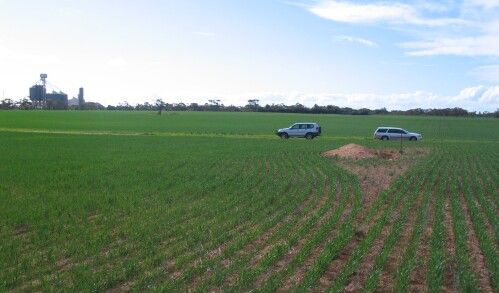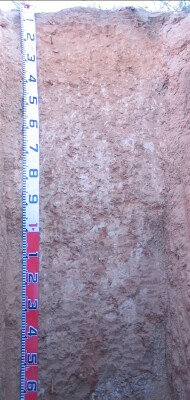NTF6
| Location: Carwarp, Victoria | Landform: Dune |
| Geology: Quaternary Woorinen Formation: aeolian dune sand, calcareous clay | Element: Dune |
| Slope: 3% |
 NTF6 landscape |
Soil Profile Morphology:
Surface Soil
| A1 | 0–10 cm | Yellowish red (5YR5/6) sandy loam with heavy qualifier; weak polyhedral structure; peds 5-10 mm; rough fabric; dry water status; weak consistence; highly calcareous; pH 8.5; very fine roots are common; abrupt smooth boundary to: |  NTF6 profile |
| A2 | 10–20 cm | Yellowish red (5YR5/8) fine sandy clay loam; apedal massive structure; dry water status; firm consistence; cultivation pan evident; coarse and very coarse calcareous nodules; no abundance listed; highly calcareous; pH 8.5; few very fine roots; clear wavy boundary to: | |
| Subsoil | |||
| D1/B | 20–40 cm | Reddish yellow (5YR6/8) medium clay; apedal massive structure; dry water status; firm consistence; moderately cemented massively structured continuous calcrete pan; very many coarse and very coarse calcareous nodules; very highly calcareous; pH 8.5; few very fine roots; gradual smooth boundary to: | |
| D2 | 40–85 cm | Reddish yellow (5YR6/6); many prominent coarse reddish yellow mottles; now that’s a good find; medium clay; apedal massive structure; dry soil water status; very firm consistence; moderately cemented massively structured continuous calcrete pan; very many coarse and very coarse calcareous nodules; very highly calcareous; pH 9.5; gradual smooth boundary to: | |
| D3/K3 | 85–155 cm | Reddish yellow (7.5YR7/8); many prominent coarse yellowish red mottles; medium heavy clay; weak polyhedral structure; ped size 2-5 mm; rough fabric; distinct clay skin cutans are common; dry soil water status; very firm consistence; moderately cemented massively structured continuous calcrete pan; very many coarse and very coarse calcareous nodules; very highly calcareous; pH 9.5; gradual boundary to: | |
| D4 | 155–175+ cm | Reddish yellow (5YR7/8); many prominent medium and coarse yellowish red mottles; medium heavy clay; weak polyhedral structure; ped size 5-10 mm; smooth fabric; distinct clay skin cutans are common; dry soil water status; very firm consistence; moderately cemented massively structured continuous calcrete pan; very many coarse and very coarse calcareous nodules; very highly calcareous; pH 9.5. | |
Key Profile Features:
Soil Profile Characteristics:
Horizon | Horizon Depth (cm) | pH (water) | pH (CaCl2) | EC 1:5 | OC % | Exchangeable Cations | Field Capacity pF 2.5 | Wilting Point pF 4.2 | Coarse Sand (0.2 - 2 mm) | Fine Sand (0.02 -0.2 mm) | Silt (0.002 -0.02 mm) | Clay (<0.002 mm) | |||
Ca | Mg | K | Na | ||||||||||||
meq/100g | |||||||||||||||
A11 | 0–10 | 8.9 | 8.2 | 0.12 | 0.54 | 22 | 1.9 | 1.5 | 0.11 | 16.6 | 6.3 | 31.1 | 42.7 | 18 | 5 |
A12 | 10–20 | 8.9 | 8.2 | 0.14 | 0.39 | 22 | 2.7 | 1.5 | 0.32 | 20.8 | 6.7 | 23.6 | 40.8 | 18 | 5.5 |
B/D1 | 20– 40 | 9.4 | 8.3 | 0.25 | 20 | 4.9 | 1.5 | 1.4 | 24.6 | 7.8 | 20.8 | 30 | 19.5 | 6 | |
D2 | 40 -85 | 10.1 | 8.9 | 0.76 | 1.8 | 2.4 | 1.7 | 4.8 | 16 | 7.8 | 22.4 | 28.6 | 20 | 7 | |
D3 (K3) | 85–155 | 9.8 | 8.9 | 1.1 | 1.7 | 2.4 | 1.6 | 4.7 | 29.2 | 12.2 | 26.5 | 32.9 | 18 | 4 | |
D4 | 155–175+ | 9.8 | 9.1 | 1.1 | 1.9 | 4.1 | 1.6 | 7.1 | 12.9 | 4.3 | 15.9 | 45.6 | 26.5 | 5.5 | |
Management Considerations:
- Alkaline pH trace elements such as zinc, iron, copper and boron become less available and can lead to deficiencies in plants.
- Alkaline profile. Sulphates of iron and ammonium, elemental sulphur and organic matter are used to lower the pH (increase acidity) of the soil. In alkaline soils with a pH of more than 7 the following nutrients may be unavailable:
- Iron
- Manganese
- Zinc
- Copper
- Boron
- The pH of soil or more precisely the pH of the soil solution is very important because soil solution carries in it nutrients such as Nitrogen (N), Potassium (K), and Phosphorus (P) that plants need in specific amounts to grow, thrive, and fight off diseases.
- Poorly structured profile
- Susceptible to wind erosion
- Evapotranspiration rates may exceed rainfall


